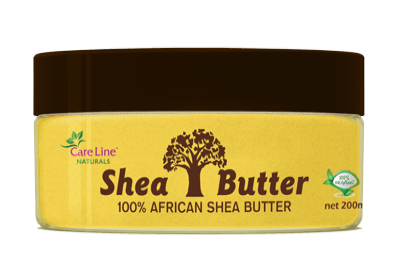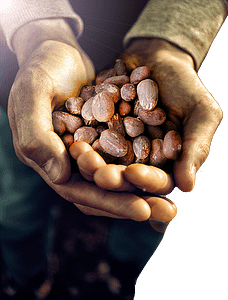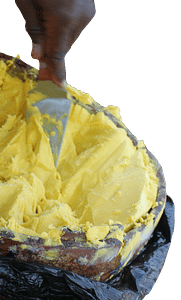
Producing shea butter is no easy process. Shea nut trees, also known as the vitellaria, doesn’t immediately produce nuts. It can take between 10 to 15 years before it starts bearing fruit and it could be as long as 30 years before full production is attained. Shea nut trees can continue to produce fruit for up to 200 years, making them a long lasting means of production.

Premium Natural Quality
Shea Butter
Extracted from the nut of the African Shea tree, packed in an unrefined form, CareLine provides a purely organic natural moisturiser with exceptional healing properties for the skin. conditions, including blemishes wrinkles, and sunburns, and a number of other conditions of the skin in addition to being a superior moisturiser.
Rich in Vitamins A, E, F, Shea Butter is impactful for improving a number of skin.
Harvesting
Producing shea butter is no easy process. Shea nut trees, also known as the vitellaria, doesn’t immediately produce nuts. It can take between 10 to 15 years before it starts bearing fruit and it could be as long as 30 years before full production is attained. Shea nut trees can continue to produce fruit for up to 200 years, making them a long lasting means of production.
The shea fruit look a lot like large plums and the shea nut resides beneath the fruit’s flesh. Each tree can produce as much as 45 kilograms of fruit every year, and each piece of fruit can contain as much as 400 grams of dry shea nut seeds that are used to produce shea butter.
Shea butter production has been immensely important for the people of Ghana for centuries. Shea butter is most often used in skincare in America, but in Ghana it has a rich history as a food resource. Shea butter has been used to cook food in Ghana throughout history and is still today!
One of the most important things to be aware of when looking out for a high quality Shea butter is whether or not it is raw.
Another important part of making sure your Shea butter is of a high quality is the source. You want to choose a Shea butter source that is ethical, fair trade and environmentally friendly
Quality Pickin
A high quality Shea butter does not go bad easily and does not have a chemical smell. If a Shea butter does have a plastic-like or otherwise chemical type of odor, chances are it has been treated with some kind of deodorizer or otherwise refined—which is not good. A high quality Shea butter will have a mild scent that is a bit earthy or nutty.

Shea butter is sometimes called “women’s gold” because it provides employment and income to women in 19 African nations. These nations are home to the Karite (or Shea) tree. It’s a tree that produces the nuts that are used to make Shea butter. This tree can take up to fifty years to reach maturity and is considered a precious commodity due to the nuts it provides. We source all of our Shea butter from fair local trading efforts in Ghana, where women harvest Shea nuts by hand.
A block of Shea butter begins its life as a pile of nuts. These nuts are boiled in a large pot, which makes the shell easier to break. When the nuts are cooled, they are extracted from their shells. This extracting process is done by hand, and while it can be time-consuming, it is often done by groups of women who make it a social activity.
The discarded shells are used for cooking fuel, while the seeds are cracked and roasted. The roasted seeds are then beaten with water, which releases their rich fats. These extracts are boiled, skimmed, and cooled, which results in the Shea butter we all know and love







